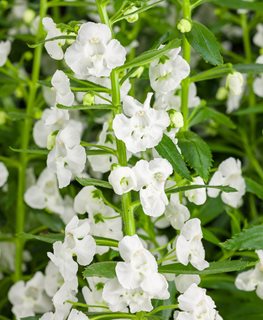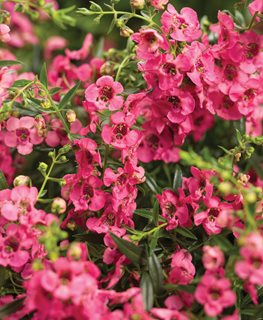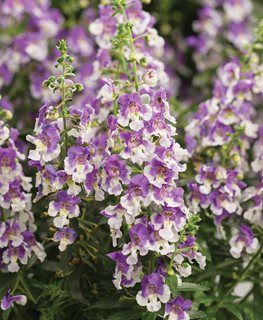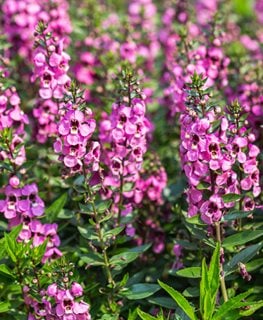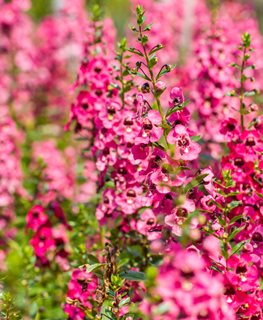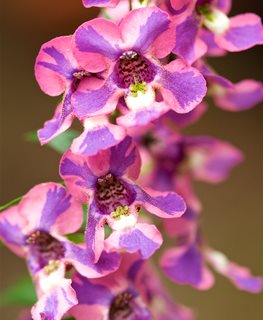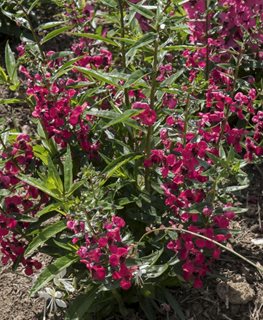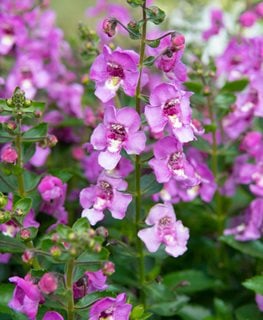HOW TO GROW & CARE FOR ANGELONIA (SUMMER SNAPDRAGON)
Prolific blooms of this delightful annual sizzle in the heat of summer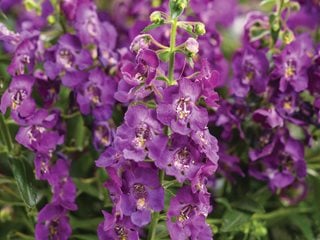
Angelface® Blue angelonia. Photo by: Proven Winners.
When cool-season annuals take a break during the heat of summer, angelonia plants pick up the pace. This snapdragon look-alike blooms nonstop from late spring through fall, adding a cheerful splash of color to the landscape. Unlike snapdragons that fade in mid-summer, angelonia plants thrive in heat, even in hot and humid regions of the south.
This semi-tropical plant is treated as an annual in all but the warmest climates. Also known as summer snapdragon, the delicate tubular flowers are a magnet for hummingbirds, butterflies, and insect pollinators. With a wide range of flower colors and forms to choose from, this virtually carefree annual makes a versatile addition to beds, borders, and containers.
On this page: Basics | Planting | Care | How to Choose the Right Angelonia | Angelonia Varieties | FAQs | Landscaping & Design Tips
On this page:
- BASICS
- PLANTING
- CARE
- HOW TO CHOOSE THE RIGHT ANGELONIA
- ANGELONIA VARIETIES
- FREQUENTLY ASKED QUESTIONS
- LANDSCAPING & DESIGN TIPS
BASICS
Zones:
Hardy in zones 9-11; grown as an annual in colder zones
Height/Spread:
Upright or spreading habit, 1 to 3 feet tall and 1 to 2 feet wide
Exposure:
Full sun
Bloom time:
Late spring through fall
Flower color and characteristics:
Vertical flower spikes up to 8 inches long produce dozens of 3/4-inch flowers on a single stem. Flowers are two-lipped and slightly tubular, in colors of purple, blue, pink, red, lavender, coral, white, and bicolors.
Foliage:
Narrow lance-shaped green leaves 1-½ to 3 inches long have slightly toothed margins. Foliage is faintly scented with an apple or grape-like aroma, which is more pronounced on warm evenings.
Deer resistance:
Considered deer-resistant, though deer may nibble in extreme conditions. See more deer-resistant plants.
PLANTING
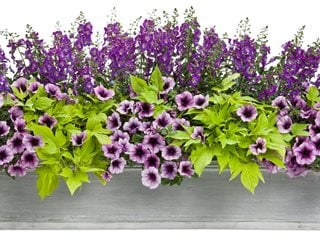
Parisian Nights container recipe, includes Angelface® Blue angelonia, Supertunia® Bordeaux™ petunia, and Proven Accents® ‘Sweet Caroline Light Green’ sweet potato vine. Photo by: Proven Winners.
When to plant:
Plant in late spring after all danger of frost has passed. According to Proven Winners, angelonia can tolerate a light late-spring frost and may rebound if touched by one. Hard freezes can damage young plants, so it’s best to wait until conditions are reliably warm.
Where to plant:
Grow on a site that receives at least 6 hours of direct sunlight in a container or the landscape.
How to plant:
Work a 2- to 3-inch layer of compost or other rich organic matter into planting beds, or use a high-quality potting soil for containers. Make sure soil is loose and well-draining. Tease out any pot-bound roots to encourage healthy plant development. Dig a hole the size of the root ball and place the plant so the top of the root ball is level with the surrounding soil. Fill in the hole with soil, tamp down gently to remove air pockets, and water thoroughly.
How to grow from seed:
Sow seeds indoors 6 to 8 weeks before your last frost date. Lightly press seeds into a sterile seed-starting mix. Angelonia seeds need light to germinate, so don’t cover them. Keep the soil surface evenly moist and don’t allow it to dry out. Seeds need temperatures of 70 to 75 degrees to germinate, so use a heat mat if necessary. Seedlings emerge in 10 to 14 days. When all danger of frost is past, gradually acclimate plants outside before transplanting into the garden. For direct sowing outdoors, wait until all chance of frost is past.
ANGELONIA CARE
Pruning:
Flowers are self-cleaning and need little or no deadheading. Spent spikes can be removed, but not necessary. To rejuvenate plants, cut back by half in mid summer and fertilize.
Soil:
Angelonia prefers rich, well-draining soil with a slightly acidic pH between 5.5 and 6.2.
Amendments & fertilizer:
Angelonia is a relatively light feeder compared to many other summer annuals. Apply an all-purpose fertilizer monthly or use a time-release fertilizer according to instructions. Mulch around plants with a layer of organic matter such as compost to suppress weeds and retain moisture.
Watering:
Keep soil evenly moist but not soggy. Water when the top layer of soil is dry to the touch. Keep plants watered 2 to 3 times a week until established. Once established, plants are somewhat drought tolerant. As the team at Spoken Garden notes, “It’ll put up with a little bit of abuse on both sides—too wet, too dry. So, really cool plant.”
Deadheading:
Not required. Angelonia is self-cleaning, so deadheading isn’t required to keep the flowers coming. According to the National Gardening Association, “Each flower pretty much dries up and shrivels into nothing when it's finished, which makes deadheading a ‘do it when you feel like it’ task.” You can snip off spent spikes to tidy up or encourage fuller growth, but it’s optional.
Diseases and pests:
When planted in optimal conditions and properly maintained, angelonia is virtually problem-free. Pests include aphids, which can be removed with a gentle spray of water. Powdery mildew may occur in humid conditions or with poor air circulation.
HOW TO CHOOSE THE RIGHT ANGELONIA
For borders and landscapes:
Larger varieties will offer maximum impact. Any variety can be massed in the landscape or used as edging in a mixed border or along a pathway.
For slopes and hillsides:
Mass any variety along a bank or slope for a colorful, low-maintenance display that will also help stem erosion.
For containers:
Depending on the type, angelonia can be used as a thriller, filler, or spiller in combination with other annuals with similar growing needs.
ANGELONIA VARIETIES
FREQUENTLY ASKED QUESTIONS
Does angelonia come back every year?
Angelonia is a tender perennial in USDA Zones 9–11 but is typically grown as an annual in colder zones. In warm climates, it may overwinter or reseed, but in most areas, it won’t survive frost.
Can angelonia be grown in pots?
Absolutely. Angelonia thrives in containers and can be used as a filler, thriller, or even a spiller depending on the variety. Just make sure it gets full sun and well-draining soil.
Do you need to deadhead angelonia?
No! Angelonia is self-cleaning and doesn’t require deadheading to keep blooming. You can snip off spent spikes to tidy up or encourage fuller growth, but it’s not necessary.
Is angelonia deer resistant?
Yes, angelonia is generally considered deer resistant. While no plant is completely deer-proof, they tend to leave angelonia alone unless food is scarce.
Is angelonia drought tolerant?
Once established, yes. Angelonia can tolerate short dry spells, but it blooms best with consistent moisture and good drainage.
What's the difference between angelonia and snapdragon?
Angelonia is often called "summer snapdragon" because of its similar flower shape, but unlike true snapdragons (Antirrhinum), it thrives in heat and humidity and blooms all summer long.
LANDSCAPING & DESIGN TIPS
There are many ways to incorporate angelonia into your landscape. Here’s how:
- Plant along the edge of an informal cottage-style border for a quaint and timeless look.
- Place in a container with a compelling focal point such as purple fountain grass and a trailer such as petunias for a filler, spiller, thriller effect.
- Edge a sunny pathway for nonstop bloom all summer long.
- Plant in front of a mixed border with perennials, trees and shrubs for color throughout the growing season while other plants go in and out of bloom.
- Mass along a slope, alternating colors such as blue and pink for visual contrast.
- Plant with snapdragons, which bloom during cooler months in spring and fall, for a continuous display of similar-looking flowers through the season.
- For window boxes and hanging baskets, plant as a stand-alone accent or in combination with other annuals with similar growing needs.
- Place a single dwarf specimen in a decorative pot and place on a sunny patio as a tabletop centerpiece to enjoy during al fresco dining.
PRO TIP: Angelonia's upright stems and subtle fragrance make it a lovely and long-lasting addition to summer cut-flower arrangements.
Companion plants:
Angelonia combines well with a wide array of other annuals. including:
ABOUT THE AUTHOR
Janet Loughrey is a veteran garden writer and photographer with over 25 years of experience, contributing to major publications like Garden Design, Better Homes and Gardens, and Sunset. A former Master Gardener, she brings hands-on expertise from gardening in a wide range of climates, from upstate New York to the Pacific Northwest.
RELATED:
Annual Flowers
Amazing Annual Flowers for Sun
Annuals You’ll Love
20 Flowers for Your Summer Garden
